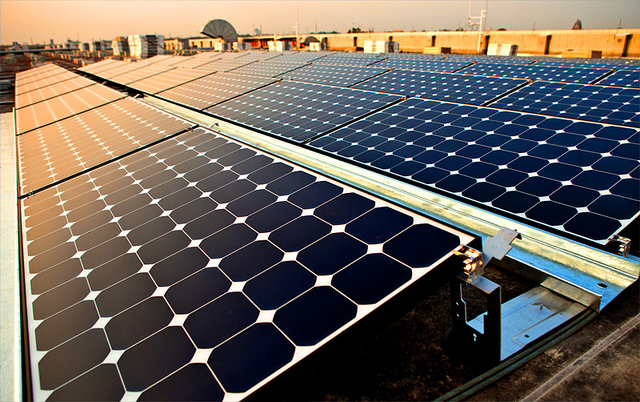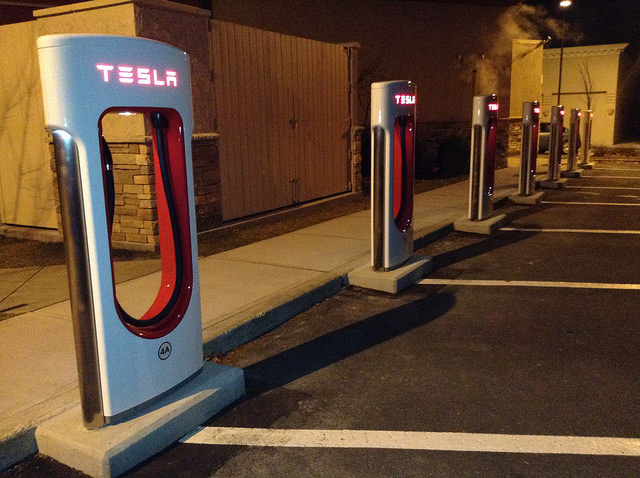
Going Solar
This week’s top stories seem to circle around solar power, so let’s have a look:
Apple announced plans earlier this week to invest big in solar — to the tune of $848 million — to provide electricity for its new campus. Under the deal with solar electricity producer First Solar, Apple’s investment will grant it 130 MW of the total 280 MW output for the next 25 years. The rest of the electricity generated at the 2900 acre California Flats Solar Project will go to the other major investor, Pacific Gas and Electric, for an undisclosed sum. While it appears to be the biggest solar purchase made by a commercial “end-user” to date, Apple’s no newcomer to the business: its Maiden, NC sapphire manufacturing plant has a 20 MW solar farm to help provide for its energy consumption. Check out the press release from First Solar for more.

Elon Musk’s latest news is tied to solar as well, if not directly. Earlier this week in a conference call with investors, Musk said to expect the unveiling of a Tesla-made battery pack for your home in the near future. If that doesn’t sound like solar power news, think again. According to this article at The Verge, the Tesla “Gigafactory” is already set to make batteries for SolarCity (which happens to be “a company chaired by Musk and run by his cousin Lyndon Rive”). That means not only is Tesla hoping to make home batteries, it’s hoping to make them specifically for solar power generating consumers. Why does that matter? Well the TL;DR is that solar’s great when the sun’s shining — but not so great when it’s not. And if you can store up two or three days’ worth of electricity, suddenly not being on the grid doesn’t sound so bad. What’s more, if you are on the grid (even if you don’t have panels) you can make a pretty penny selling the grid’s power back to it at peak times. All of this is good for the grid, of course, because renewables tend to be intermittent. Check out the article at The Verge for more.

SpaceX News
This week there are two stories from SpaceX. First, the CRS-5 Dragon capsule is back from its stay aboard the International Space Station. The capsule splashed down February 10 after a month in orbit, returning plenty of “downmass” to Earth. At present the Dragon capsules are the only American vehicles capable of returning items from the ISS. Check out the (very detailed) story from NASAspaceflight.com.
The other piece of news concerns the launch of the Goresat (otherwise known as DSCOVR) to L1 by a Falcon 9 on February 11. After being delayed a few times (as seems to be the usual case) due at first to a tracking issue, then labour regulations, then high winds, the probe set off on its mission to provide a realtime video feed of the sunlight side of the Earth. The story behind the probe, originally the brainchild of Al Gore and named Triana, is a peculiar one, and one worth reading about if you get the time. The long and short of it is that after sitting in mothballs for years, the satellite finally became the cheapest way NOAA could think of to replace the 17-year-old Advanced Composition Explorer (ACE) which provides the first warning of solar storms headed our way. It’s the first time SpaceX has launched something so far, and although the weather out to sea was too stormy to allow for recovery of the first stage, it appears that even in high winds it landed right on target and totally vertical, raising hopes for the first recovery some time soon.
Landing on a stormy sea pic.twitter.com/7EY25g3IU5
— Elon Musk (@elonmusk) February 12, 2015
Check out the youtube video below to see the launch!
Systemic Exertion Intolerance Disease
Chronic Fatigue Syndrome got a new name this week, after a panel put together by the Institute of Medicine decided that neither CFS, nor its alias Myalgic Encephalomyelitis (ME), were appropriate names for the disease, which has a long list of debilitating symptoms, but no determined cause (as yet). The new name is Systemic Exertion Intolerance Disease, or SEID, and is meant to underscore to the public and clinicians alike that the condition is a very real and very problematic disease. They decided that the most unifying symptom is what they call post-exertional malaise — a profound exhaustion following even mild physical or mental exertion — and renamed the condition based upon that. It is hoped that the name change — which is set to be re-evaluated in five years’ time — will spur interest and funding. At present, much of what can be said of the mysterious disease is that patients seem to have “abnormal immune systems.” Check out the story at NPR for more.
Spot
Google-owned robotics company (and maker of Big Dog) Boston Dynamics is at it again. This time, they’ve made a little dog they’re calling Spot. It’s nimble, about the size of a large golden retriever, and will probably haunt your dreams. Maybe it’s the fact that they’re headless, or that they seem to work together, or that it’s easy to imagine them armed with weapons and hunting down humans in packs, but something about them makes me think twice about whether Elon Musk is out to lunch when he says we should be wary of AI. Anyway here’s a link so you can be scared, too.
Cholesterol
The US’s Dietary Guidelines Advisory Committee has released a new recommendation this week regarding cholesterol. Or rather, it hasn’t. The DGAC this week refrained from saying anything about cholesterol, except that it’s no longer considered a “nutrient of concern.” Why were we worried about cholesterol in food in the first place? Well at one point, in the 1960s, it was thought that the cholesterol we eat finds its way into our bloodstream — which is still bad. But in recent years it’s become pretty clear that dietary cholesterol bears much less in common with blood cholesterol than things like dietary saturated fats. Basically, it means I don’t need to worry about the roughly two-dozen eggs I go through every couple of weeks. Now as for those cans of spam… anyway, here’s a link for more.
Megadrought
If the US needed another reason to care about climate change, here it is: a new study has announced that a megadrought — a severe drought lasting ten years or more — is a virtual certainty in the US southwest in the next century. For comparison, the current drought affecting California has been going on for four years, and it’s already reaching crisis proportions. I’ll be blunt: with the amount of US food grown in the southwest, especially California, and the amount of people living there, desalination is looking like it’s going to need to take a major leap into the future if we’re going to continue as normal. Just saying. Check out this WaPo link for a pretty detailed explanation.
Best of the Rest
Like every week before this one, I had far more to cover than I got to. So, here’s some more: NASA wants to go to Titan and take along a submarine; Louisiana is getting more land off the coast; ESA flew its space plane prototype this week; Facebook has a bounty out for bugs; the LHC is gearing up to start up again soon; and if you live in the US, cell carrier now have to unlock your phone if you’re no longer under contract. How’s that for good news?
That’s all for today. Tell all your friends about the site, and have a great week.
